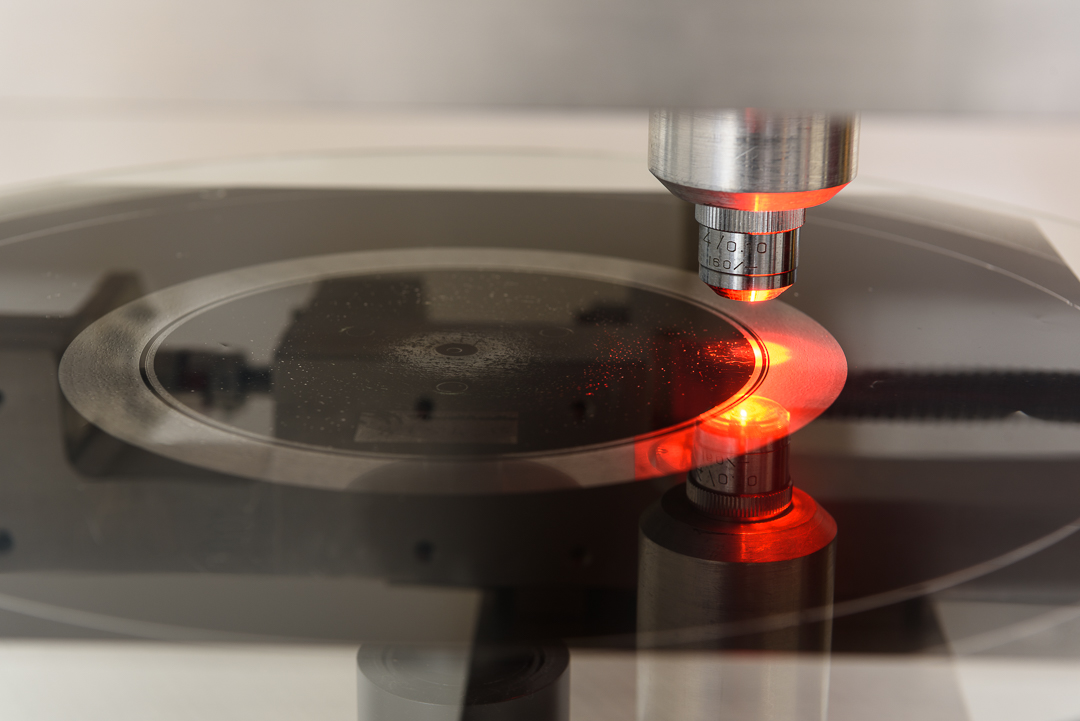|
VisualAudio
VisualAudio is a project that retrieves sound from a picture of a phonograph record. It originated from a partnership between the Swiss National Sound Archives and the School of Engineering and Architecture of Fribourg. Introduction Discs were the only means of preserving sound before the introduction of magnetic tapes. Until the advent of the vinyl in the 1950s, the records were made of shellac or wax. The organic composition of these materials enabled them to degrade over time and also made them prone to attack by fungi. As a result, many records, including unique original radio productions, are in a state of deterioration which precludes play by traditional mechanical means, hence the interest in a non-contact approach. History The idea of this recovery of the sound of old records through optical scanning started in the summer of 1999 in Lugano, among the technical manager of the Swiss National Sound Archives (''Fonoteca Nazionale'') Stefano S. Cavaglieri (creator and hol ... [...More Info...] [...Related Items...] OR: [Wikipedia] [Google] [Baidu] |
Digitisation
DigitizationTech Target. (2011, April). Definition: digitization. ''WhatIs.com''. Retrieved December 15, 2021, from https://whatis.techtarget.com/definition/digitization is the process of converting information into a digital (i.e. computer-readable) format.Collins Dictionary. (n.d.). Definition of 'digitize'. Retrieved December 15, 2021, from https://www.collinsdictionary.com/dictionary/english/digitize The result is the representation of an object, image, sound, document, or signal (usually an analog signal) obtained by generating a series of numbers that describe a discrete set of points or samples. The result is called '' digital representation'' or, more specifically, a '' digital image'', for the object, and ''digital form'', for the signal. In modern practice, the digitized data is in the form of binary numbers, which facilitates processing by digital computers and other operations, but digitizing simply means "the conversion of analog source material into a numeric ... [...More Info...] [...Related Items...] OR: [Wikipedia] [Google] [Baidu] |
Laser Turntable
A laser turntable (or optical turntable) is a phonograph that plays standard LP records (and other gramophone records) using laser beams as the pickup instead of using a stylus as in conventional turntables. Although these turntables use laser pickups, the same as Compact Disc players, the signal remains in the analog realm and is never digitized. History William K. Heine presented a paperA Laser Scanning Phonograph Record Player to the 57th Audio Engineering Society (AES) convention in May 1977. The paper details a method developed by Heine that employs a single 2.2 mW helium–neon laser for both tracking a record groove and reproducing the stereo audio of a phonograph in real time. In development since 1972, the working prototype was named the "LASERPHONE", and the methods it used for playback was awardeU.S. Patent 3,992,593on 16 November 1976. Heine concluded in his paper that he hoped his work would increase interest in using lasers for phonographic playback. ... [...More Info...] [...Related Items...] OR: [Wikipedia] [Google] [Baidu] |
Swiss National Sound Archives
The Swiss National Sound Archives are the sound archives of Switzerland, based in Lugano. Its mission is to collect sound recordings related to the history and culture of Switzerland, to make them accessible and to make them available for use. In terms of audio recordings, it thus fulfils a similar function to the Swiss National Library in the field of literature. Since 2016, the National Sound Archives have been an organisational part of the Swiss National Library. The collection has more than 500,000 audio carriers and 20-25,000 audio documents are added each year (as of 2018). The institution is a member of the International Association of Sound and Audiovisual Archives (IASA) and the Audio Engineering Society (AES). The Swiss National Sound Archives is also a member of the Association for Recorded Sound Collections (ARSC) and the International Association of Music Libraries, Archives and Documentation Centres (IAML). History There were 15 years between the idea of a Swis ... [...More Info...] [...Related Items...] OR: [Wikipedia] [Google] [Baidu] |
IRENE (technology)
IRENE (''Image, Reconstruct, Erase Noise, Etc.'') is a digital imaging technology designed to recover analog audio stored on fragile or deteriorating phonograph cylinders, records, and other grooved audio media. It is in use by several archives and preservation institutions in the United States seeking to preserve and digitize historical audio. History The technology was developed at Lawrence Berkeley National Laboratory by Carl Haber and Vitaliy Fadeyev and was announced in a publication of the ''Journal of the Audio Engineering Society'' in 2003.Vitaliy Fadeyev and Carl Haber, ''Reconstruction of Mechanically Recorded Sound by Image Processing''. ''Journal of the Audio Engineering Society'', 2003.PDF It grew out of Haber's research in particle physics; in the 1990s, he had worked on Higgs boson detection experiments, and realized that the cameras he was using to set the detectors could also be used for detailed imaging of grooved audio recordings. The name IRENE is a backronym ... [...More Info...] [...Related Items...] OR: [Wikipedia] [Google] [Baidu] |
Aldo Spallicci , a town in Argentina
{{disambiguation ...
Aldo may refer to: * Aldo (given name), male given name ** Aldo (footballer, born 1977) ** Aldo (footballer, born 1988) * Aldo Group, a worldwide chain of shoe stores * Aldosterone in shorthand * Aldo Bonzi Aldo Bonzi is a town in La Matanza Partido, Buenos Aires Province, Argentina. It is located within the Greater Buenos Aires metro area. The town owes its name to Turin-born businessman Dr. Aldo Bonzi (1852–1935), who arrived in Argentina in ... [...More Info...] [...Related Items...] OR: [Wikipedia] [Google] [Baidu] |
Signal-to-noise Ratio
Signal-to-noise ratio (SNR or S/N) is a measure used in science and engineering that compares the level of a desired signal to the level of background noise. SNR is defined as the ratio of signal power to the noise power, often expressed in decibels. A ratio higher than 1:1 (greater than 0 dB) indicates more signal than noise. SNR, bandwidth, and channel capacity of a communication channel are connected by the Shannon–Hartley theorem. Definition Signal-to-noise ratio is defined as the ratio of the power of a signal (meaningful input) to the power of background noise (meaningless or unwanted input): : \mathrm = \frac, where is average power. Both signal and noise power must be measured at the same or equivalent points in a system, and within the same system bandwidth. Depending on whether the signal is a constant () or a random variable (), the signal-to-noise ratio for random noise becomes: : \mathrm = \frac where E refers to the expected value, i.e. in this case ... [...More Info...] [...Related Items...] OR: [Wikipedia] [Google] [Baidu] |
Decibel
The decibel (symbol: dB) is a relative unit of measurement equal to one tenth of a bel (B). It expresses the ratio of two values of a power or root-power quantity on a logarithmic scale. Two signals whose levels differ by one decibel have a power ratio of 101/10 (approximately ) or root-power ratio of 10 (approximately ). The unit expresses a relative change or an absolute value. In the latter case, the numeric value expresses the ratio of a value to a fixed reference value; when used in this way, the unit symbol is often suffixed with letter codes that indicate the reference value. For example, for the reference value of 1 volt, a common suffix is " V" (e.g., "20 dBV"). Two principal types of scaling of the decibel are in common use. When expressing a power ratio, it is defined as ten times the logarithm in base 10. That is, a change in ''power'' by a factor of 10 corresponds to a 10 dB change in level. When expressing root-power quantities, a change in ''ampl ... [...More Info...] [...Related Items...] OR: [Wikipedia] [Google] [Baidu] |
Recording Industry Association Of America
The Recording Industry Association of America (RIAA) is a trade organization that represents the music recording industry in the United States. Its members consist of record labels and distributors that the RIAA says "create, manufacture, and/or distribute approximately 85% of all legally sold recorded music in the United States". RIAA is headquartered in Washington, D.C. RIAA was formed in 1952. Its original mission was to administer recording copyright fees and problems, work with trade unions, and do research relating to the record industry and government regulations. Early RIAA standards included the RIAA equalization curve, the format of the stereophonic record groove and the dimensions of 33 1/3, 45, and 78 rpm records. RIAA says its current mission includes: #to protect intellectual property rights and the First Amendment rights of artists #to perform research about the music industry #to monitor and review relevant laws, regulations, and policies Between 2001 and 202 ... [...More Info...] [...Related Items...] OR: [Wikipedia] [Google] [Baidu] |
Equalization (audio)
Equalization, or simply EQ, in sound recording and reproduction is the process of adjusting the volume of different frequency bands within an audio signal. The circuit or equipment used to achieve this is called an equalizer. Most hi-fi equipment uses relatively simple filters to make bass and treble adjustments. Graphic and parametric equalizers have much more flexibility in tailoring the frequency content of an audio signal. Broadcast and recording studios use sophisticated equalizers capable of much more detailed adjustments, such as eliminating unwanted sounds or making certain instruments or voices more prominent. Since equalizers "adjust the amplitude of audio signals at particular frequencies" they are, "in other words, frequency-specific volume knobs." Equalizers are used in recording studios, radio studios and production control rooms, and live sound reinforcement and in instrument amplifiers, such as guitar amplifiers, to correct or adjust the response of mi ... [...More Info...] [...Related Items...] OR: [Wikipedia] [Google] [Baidu] |
Band-pass Filter
A band-pass filter or bandpass filter (BPF) is a device that passes frequencies within a certain range and rejects (attenuates) frequencies outside that range. Description In electronics and signal processing, a filter is usually a two-port circuit or device which removes frequency components of a signal (an alternating voltage or current). A band-pass filter allows through components in a specified band of frequencies, called its ''passband'' but blocks components with frequencies above or below this band. This contrasts with a high-pass filter, which allows through components with frequencies above a specific frequency, and a low-pass filter, which allows through components with frequencies below a specific frequency. In digital signal processing, in which signals represented by digital numbers are processed by computer programs, a band-pass filter is a computer algorithm that performs the same function. The term band-pass filter is also used for optical filters, sh ... [...More Info...] [...Related Items...] OR: [Wikipedia] [Google] [Baidu] |
Pixel
In digital imaging, a pixel (abbreviated px), pel, or picture element is the smallest addressable element in a raster image, or the smallest point in an all points addressable display device. In most digital display devices, pixels are the smallest element that can be manipulated through software. Each pixel is a sample of an original image; more samples typically provide more accurate representations of the original. The intensity of each pixel is variable. In color imaging systems, a color is typically represented by three or four component intensities such as red, green, and blue, or cyan, magenta, yellow, and black. In some contexts (such as descriptions of camera sensors), ''pixel'' refers to a single scalar element of a multi-component representation (called a ''photosite'' in the camera sensor context, although ''sensel'' is sometimes used), while in yet other contexts (like MRI) it may refer to a set of component intensities for a spatial position. Etymology The w ... [...More Info...] [...Related Items...] OR: [Wikipedia] [Google] [Baidu] |




.jpg)

